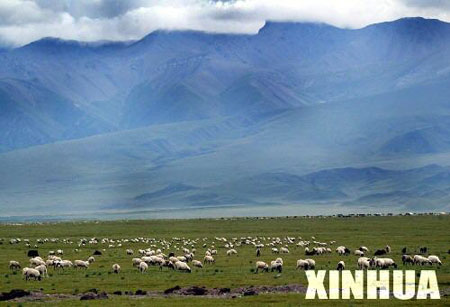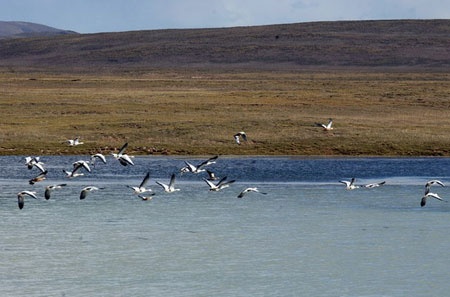Largest eco-protection project rejuvenates Sanjiangyuan area
2009-10-14 17:11 BJT
BEIJING, Oct. 7 (Xinhuanet) -- Gelai Nyima, 47, is an ordinary lama living in the Sanjiangyuan area, located in the hinterland on the Qinghai-Tibet Plateau.
In the past 23 years, he has recorded with his camera the changes that have taken place in the Sangjiangyuan area in terms of ecological environment.

Photo shows a herd of sheep browsing in the Sanjiangyuan area on the Qinghai-Tibet Plateau. (Xinhua Photo)
Thanks to the great efforts of the Central Government and local residents, Nyima‘s hometown has seen more rain and wild animals over the past few years, thus becoming a real "paradise for wildlife."
Known as the "tower of China", the Sanjiangyuan area at an altitude of 4,000 meters, is the source of Yangtze, Yellow and Lancang rivers.
Meteorological research results show that the world‘s weather is influenced by the Qinghai-Tibet Plateau, with the Sanjiangyuan area at the core.
Since the 1970s, the Sanjiangyuan area, affected by global warming and over-development, has been causing the Domino Effects. Rampant plague, glacier melting and grassland desertification have even threatened the ecological safety in the Yangtze, Yellow and Langcang river valleys.
The deteriorating ecological environment in the Sanjiangyuan area has drawn great attention of the Central Government, which earmarked 7.5 billion yuan RMB in 2005 to undertake the Sanjiangyuan ecological protection and construction project, the largest of its kind in China.
In the past four year, 50,000 herders have been relocated to urban areas and no longer lived on nomadism as before.

File photo shows barheaded gooses at a lake in the Sanjiangyuan National Nature Reserve in west China‘s Qinghai Province. (Xinhua Photo)
Four years ago, Dongbao, with 1,800 other Tibetan herders from 388 households, left the grassland and moved to a migrants‘ community in the suburbs of the seat of Maxin County, Qinghai Province.
Having attended technique training courses organized by the local government, Dongbao became a worker at a Tibetan-style carpet factory.
He said, "We were relocated for the sake of the country‘s ecological environment and in the interest of our future generations."
Also four years ago, when reporters with the Xinhua News Agency covered Maduo County, what they saw were wind-blown sand, degraded grasslands, dried-up lakes and "ecological refugees" who had to be relocated to other areas.
But now when the reporters went to Maduo County again, they saw herds of Tibetan antelopes, wild Tibetan donkeys foraging around lakes, and wild animals running on the plateau and glistering lakes.
Chen Xiaooguang, director of the Qinghai Provincial Meteorological Bureau, said that after 30 years of continuous deterioration, the Sanjiangyuan area has restored its vitality, as a result of the ecological protection project.
Li Xiaonan, deputy director of the Sanjiangyuan Office, said that in order to help the Sanjiangyuan area regain its title of "ecological paradise", the Qinghai Provincial Government has been establishing a long-term ecological compensation mechanism, in an effort to curb the ecological degradation and realize harmonious economic and social development in the region.
Editor: 卢佳颖 | Source: Xinhuanet

 Mail
Mail Share
Share Print
Print


 Video
Video









 2009 China Central Television. All Rights Reserved
2009 China Central Television. All Rights Reserved